
Without a doubt, craft beer drinkers love IPAs. According to data from Untappd, in 2021, the category “IPA – American” saw the most number of check-ins worldwide with over 7.2 million. In fact, four out of the top five most-checked in styles of the year were a subcategory of IPA.
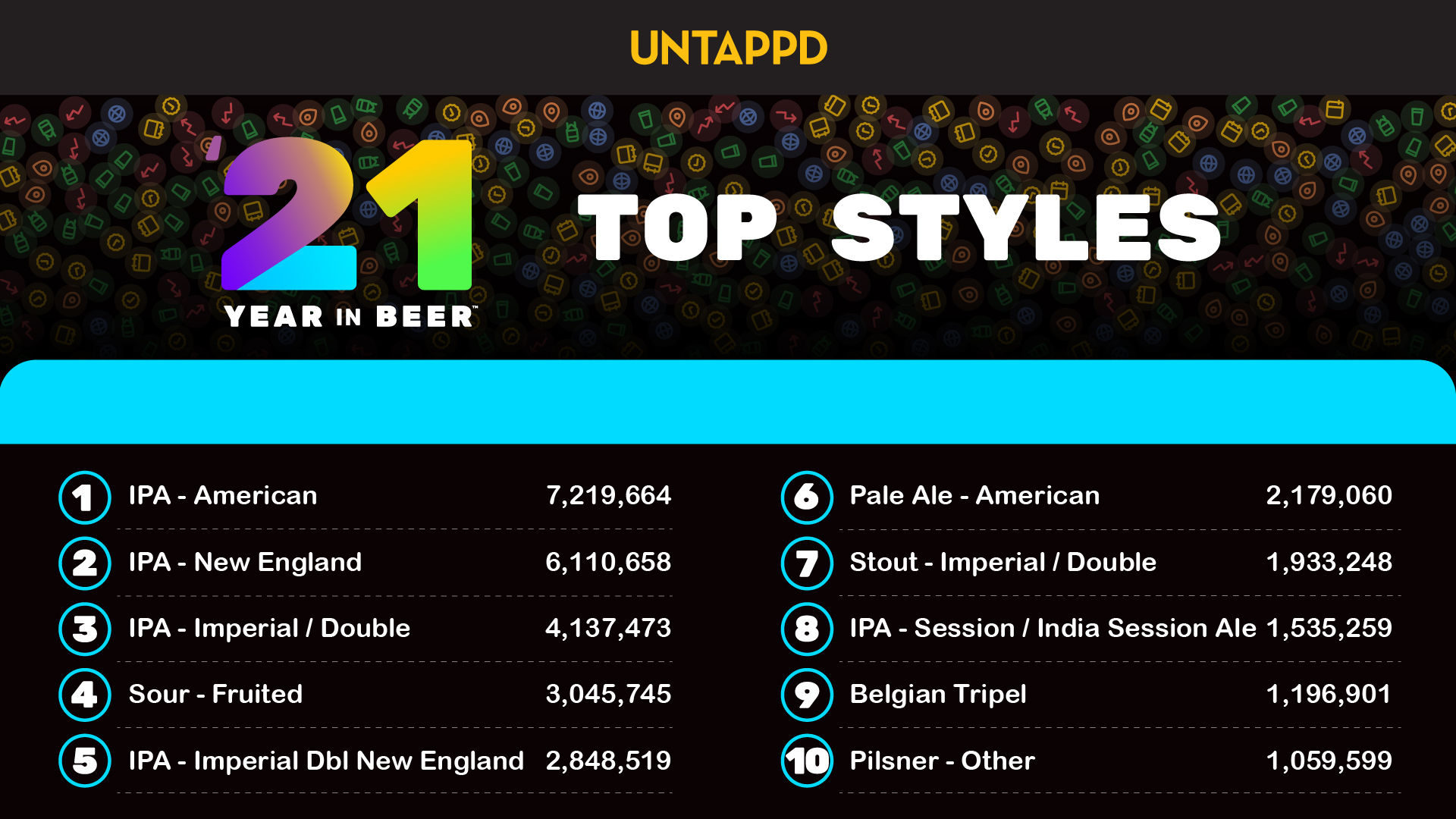
Untappd’s top 10 most checked-in styles of the year include four IPA categories in the top five spots | Graphic courtesy of Untappd
Across the world, breweries have raced to stay up to date with up-and-coming hop varieties and new products and technologies. Many that make their IPAs not only juicier, but also their brewing process more efficient, saving them time and money.
“In the last five years, the choices out there for how you can use hops as a pretty essential ingredient to making beer especially in the West Coast style and now New England / hazy juicy style is just such a continued evolution,” says Common Space Head Brewer Andy Link.”
Dry hopping is one of those techniques. Although commonplace at this point, dry hopping became so incredibly popular because it enhances hop flavor and aroma, impacts mouthfeel, and even augments perceived bitterness. That added layer of depth and complexity has made dry hopping an incredibly effective technique for giving beers a unique character.
At this point, anything on the shelf with the words “dry hopped” or “double dry hopped” (DDH) seems to immediately catch a consumer’s eye, signaling a more bitter, bolder IPA. In essence, dry hopping has certainly become an invaluable tool in a brewer’s belt, but also in a brewery’s marketing strategy as well.
Essentially, a process of boosting a beer’s hop character and flavor, dry hopping can be amazing for a consumer’s palette, but difficult on a brewer’s bottom line.
Because an additional amount of vegetal material is introduced into the wort, a percentage of that liquid will be absorbed by the hop material. Anything that’s dry hopped or double dry hopped will lead to a lower final yield.
“The more you dry hop a beer, the lower your eventual yield into a package, whether can or keg,” says Link. “That’s the laws of physics.”
Plus, there are costs, labor, and time associated with everything in a dry hop including removing the leftover hops from the beer, getting rid of that material, and even cleaning.
In a word: Dry hopping can be costly.
But what if you could get all the flavor and hop characteristics you’re looking for out of a dry hop without losing extra beer, extra time, and extra money?
Your customers would be happy with the final product. And your bottom line would be too.
A groundbreaking new product from the venerable hop supplier BarthHaas, SPECTRUM is a liquid dry-hop replacement that does exactly that.
Seems like a win-win.
So we dove deeper to discover the basics about SPECTRUM, the advantages, how to brew with it, and why every brewer should give SPECTRUM a shot.
(Featured Image: A new liquid dry-hop product from BarthHaas, SPECTRUM has many new benefits for brewers | Photograph courtesy of BarthHass)
Affordable, Industry-Leading Brewery Software
What Is SPECTRUM?
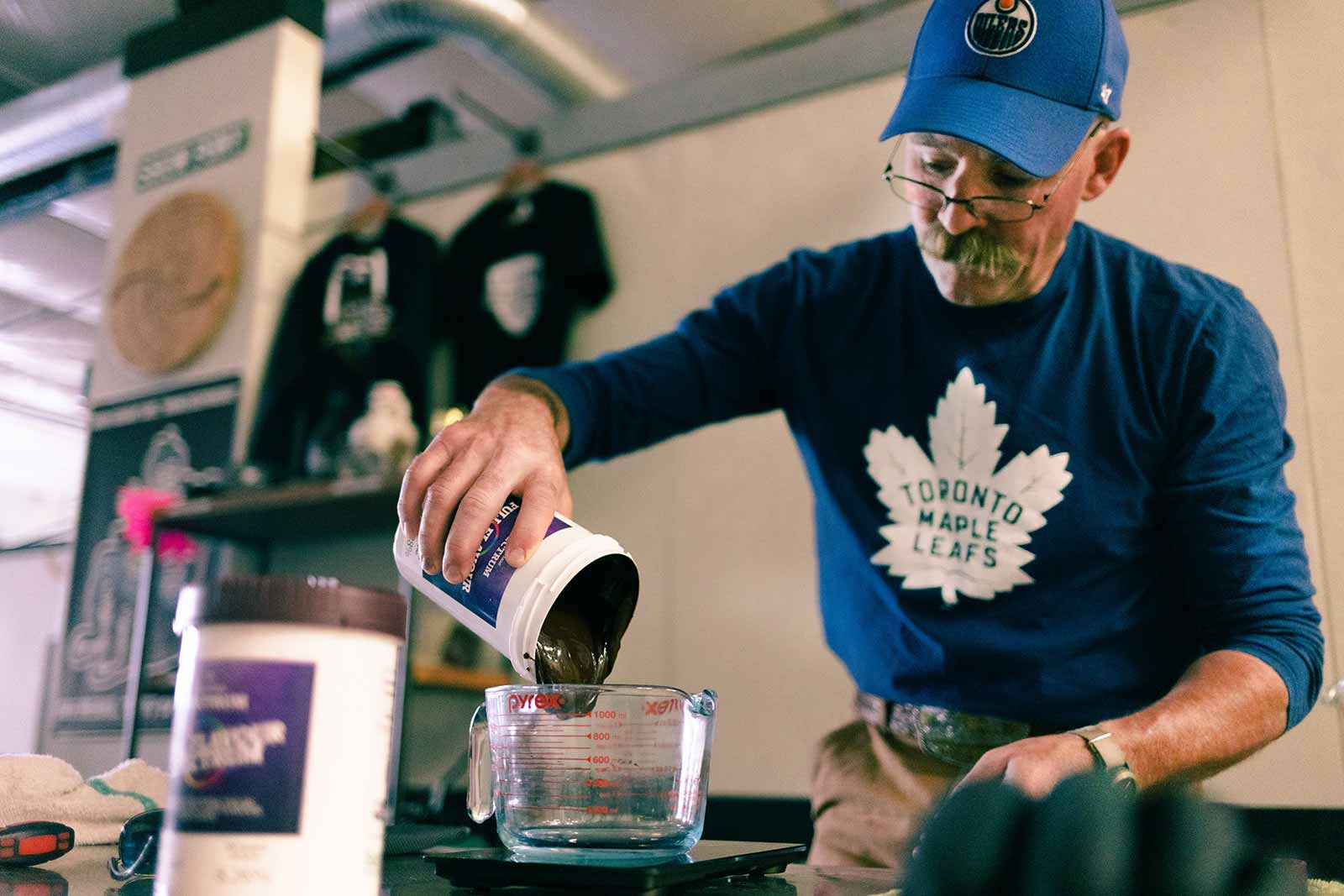
Photography courtesy of BarthHaas
One of the newest hop products we’ve seen, SPECTRUM acts as a liquid dry hop, replacing traditional T-90 hop pellets in the dry hopping process on the cold side. That’s what really sets this hop product apart.
“Until very recently a majority of these liquid alternatives have been designed for the hot side—sometimes mashing but usually in the kettle or whirlpool,” says Link. “These oils like to separate from water naturally, so using them in the cold side or the fermenter side of the brewing process have been really tough to tackle…until SPECTRUM.”

The evolution of dry-hopping products | Infographic courtesy of BarthHaas
First released by BarthHaas on July 12, 2021, SPECTRUM has slowly been making its way into the market.
Made from hop pellets and without additives or solvents, “SPECTRUM is a 100% natural 100% hop-derived product,” says Jeff Perkins, CEO and Co-Founder of Yakima Valley Hops, who has been getting SPECTRUM into the hands of their brewery partners for the last year. “They’re not infusing it with any other stuff, it’s just purely a hop-based product.”
Sort of a molasses-like hop product or slurry, SPECTRUM is “devoid of any physical green matter, so you can use it as a dry hop at different stages of the brewing process and not worry about the consequences typically associated with pelletized hops,” says Link.
A completely dispersible liquid hop product that gives beers true-to-type hop flavor, BarthHaas currently offers SPECTRUM in four different hop varieties: Australian Galaxy, Australian Enigma, Citra, and Mosaic.
“Quite a few customers use it and all really love it,” says Chris Mylroie, brewer at Yakima Valley Hops, who also started a nano brewery called Shorthead Brewing. He does sensory work on a lot of the new hop products that come down the line and has brewed extensively with SPECTRUM, testing the hop product out in different scenarios. Plus, because he owns his own nano brewery, he has the luxury of getting real-time feedback on his experiments in the market.
With more and more breweries like Common Space and Shorthead experimenting with SPECTRUM, so far, the results have been pretty successful.
What Are the Three Advantages of SPECTRUM?
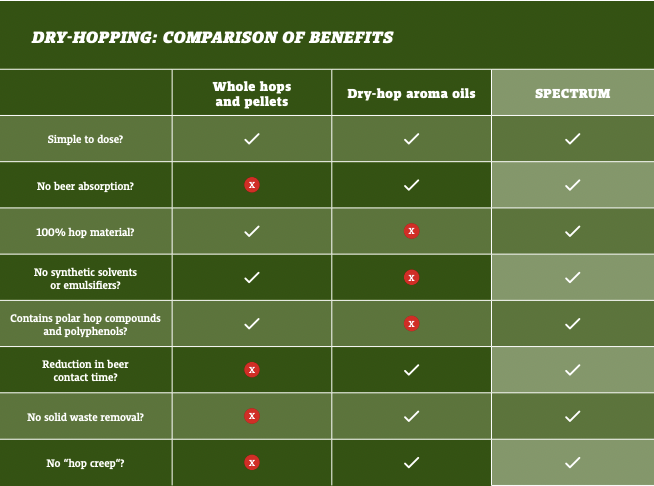
Advantages of SPECTRUM over a traditional dry hop | Infographic courtesy of BarthHaas
1. Increase Yield, Prevent Beer Loss
By far and away the biggest advantage of using SPECTRUM is that you’ll increase your yield and prevent crucial beer loss in a recipe. Of course, this exact yield will vary depending on the type of beer you’re brewing and how many T-90 pellets you’re replacing with SPECTRUM.
But overall, in two years of test trials, BarthHaas discovered that SPECTRUM significantly helps reduce beer loss found in dry hopping.
“If you’re dry hopping with three pounds per barrel, being able to cut that to a liquid is a huge gain, especially for a big brewery,” says Mylroie. “If you’re talking to breweries that are putting one hundred to two hundred pounds of hops in a batch of beer, that will soak up barrels of beer! That’s where you throw SPECTRUM in and there is no loss.”
Link has seen the results first hand at Common Space. “As business owners…we have to be conscious of the fact that, when you dry hop something liberally or aggressively, sometimes you lose a lot of beer,” he says. “With SPECTRUM you don’t have to worry about that absorption factor.”
He shares a specific example. A new bar approached Common Space and wanted to order a particularly small run of one of their beers but add in a dry hop to serve something unique to their customers.
“Typically, we would tell them we can pull off five barrels and dry hop and you’ll have to pay for five barrels, but you’re only going to get four barrels,” says Link. “With SPECTRUM, if you want to get five barrels, I can pull off five barrels, dry hop with SPECTRUM, and you’ll get five barrels.”
2. Speeds Up the Dry Hop, Time Is Money
As we all know, in almost any industry time is money. The more time beer spends in your tanks, the more you’re losing out on turning that tank, storing another beer, and getting more beer into the market.
“Brewing time is as fast as you can turn tanks, which is as fast as you can put out beers,” says Mylroie. “If you save three days on beer every time you brew that beer, say you brew four times a month, then at the end of the year that’s going to be more barrels made.”
However, a traditional dry hop, according to Mylroie, can take at least a few days. The technique by nature means hops need to stay in contact with the beer for a certain amount of time in order to develop any additional flavor and aroma. So while dry hopping a beer can immediately mean a beer might sell better on the shelf, it takes more time to get that beer out the door.
You might almost call that a Catch-22.
SPECTRUM, on the other hand, “is instant results,” says Mylroie. “You just pitch it in and it’s there. You’re not waiting twenty-four to thirty-six hours; it’s just there and done.”
Because tossing SPECTRUM into the fermenters instantly provides your beer with aroma, you don’t need to wait hours or even days to get the benefits like you would with a traditional dry hop.
3. Improves the Flavor, Keeps It Consistent
Why do you dry hop in the first place? To improve the flavor and aroma of your beer, right? SPECTRUM carries through on that promise and then some.
After brewing an all-liquid-hop-extract beer earlier this year called Space Trees (actually the third in a series of beers under the same name that test out different hop products), Link has a new appreciation for SPECTRUM.
“It’s almost a candylike expression of these hops,” says Link. “SPECTRUM is one level beyond… Where you’re getting woodsy, earthy notes [in T-90 hops], with SPECTRUM you’re getting really isolated bright aromas of citrus or tropical fruit.”
Beyond the unique flavor characteristics, SPECTRUM stays consistent across the board.
For example, according to Link, for that whole crop year you’re not getting one lot of SPECTRUM in May and a different lot of SPECTRUM in November; it’s the same for the entire year.
Meaning as a brewer, “it helps you dial in a recipe as far as a particular character, flavor, and aroma,” says Link, mentioning that if that’s the exact flavor Common Space wants in a beer, they can rely on SPECTRUM in a certain hop variety to deliver for the entire year. “I know exactly what I’m going to get when I use the product and I like it for these qualities.
With a still fairly unstable supply chain worrying breweries, having a true-to-type product that’s reliable every single time makes a huge difference.
Save on Shipping, Cooler Space
Because SPECTRUM actually weighs less and essentially comes in a reasonably sized 1kg, 5kg, or 10kg jug, you save on both shipping costs and space in your walk-in cooler.
This may seem like an esoteric advantage, but money saved is money saved.
Those small differences can really add up.
The Best Tips and Tricks for Brewing with SPECTRUM
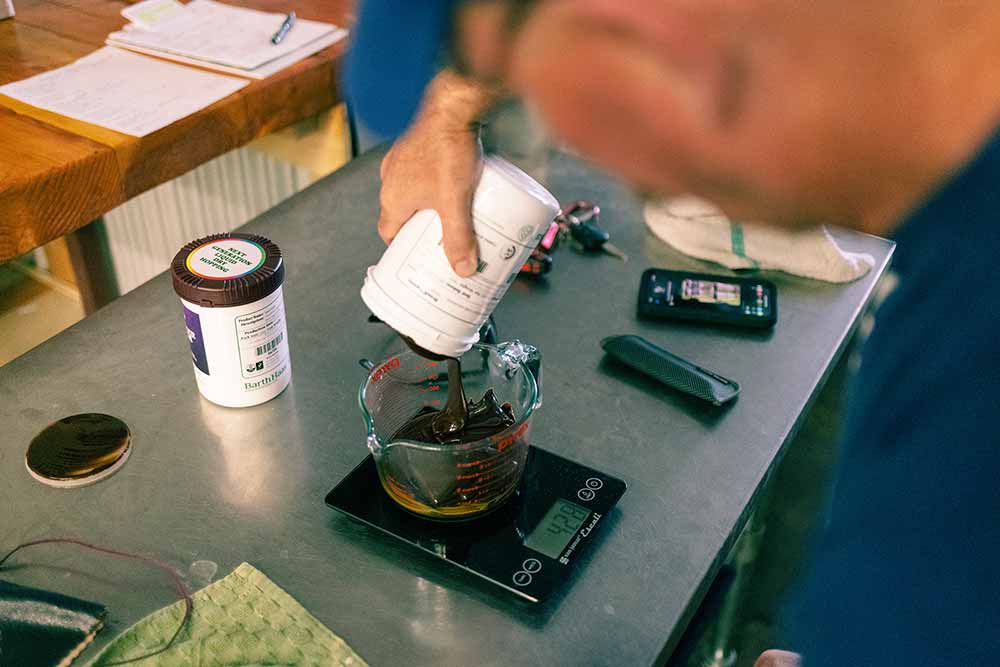
Photography courtesy of BarthHaas
SPECTRUM is fairly simple to use in a recipe, but there are a few tips and tricks to keep in mind.
First, remember that this is a new product (only a little over a year old), meaning brewers are still tweaking how they use it.
But since BarthHaas has been experimenting and testing this product for the last five years, they do lay out a few rules you can follow to start.
The Standard SPECTRUM Replacement Rate
BarthHaas suggests that the standard replacement ratio for SPECTRUM in a dry hop is 1:5 – 1:8 or one kilogram of SPECTRUM for every five to eight kilograms of T-90 hop pellets.
To start, they recommend introducing the liquid hop with lower replacements and dosage rates, working towards finding what they call the “sweet spot” of a given recipe (BarthHaas SPECTRUM Next Generation Liquid Dry Hopping Report).
Mylroie gives the same recommendation to start on the smaller side of things. He says you should calculate twenty percent of your dry hop weight and throw in that amount of SPECTRUM, building from there.
Regardless of your final dosage rate, BarthHaas advises that you replace no more than seventy percent of your dry hop with SPECTRUM.
Because SPECTRUM is so highly concentrated, adding more than seventy percent means you could start missing a certain flavor or mouth feel out of the extracts. Or you could go over the top and actually negatively affect the final beer.
“Starting high is a really terrible idea,” Mylroie laughs. “I’ve done that and I definitely had some pretty hot beers.”
Beware of Hop Burn
There is a law of diminishing returns here. Use too much SPECTRUM or replace more than eighty percent of your dry hop and you could run into hop burn. “SPECTRUM has a lot of hop oils so you can get hop burn out if it,” Mylroie says. “Plus, it’s less forgiving the later you put it in, so tread with caution.”
Break Up SPECTRUM Before Going Into Your Dry Hop
Pouring out an almost dark molasses syrup, SPECTRUM is fairly viscous and not something you can really just plop into the tank. “It looks like a really, really thick chocolate syrup,” says Mylroie. “It’s definitely thick and you want to break that down.”
While BarthHaas reports that you don’t need any special equipment to dose with SPECTRUM, they do recommend adding it into lukewarm deaerated water or wort and stirring it around before pitching it into the tank.
SPECTRUM is pretty thick at room temperature, so placing it in a warm liquid (40 degrees centigrade) will lower its viscosity, making it easier to use.
ProTip: If you’re storing SPECTRUM in your cold box, make sure you take it out and let it warm up to room temperature before giving it a nice little bath. Otherwise you’ll spend more time trying to get SPECTRUM to a workable level.
For Mylroie, who brews on a pretty small system, he simply fills up a Nalogene with chilled wort, doses it with SPECTRUM, and shakes it up to make it a bit more liquidy and workable before pitching it into his dry hop.
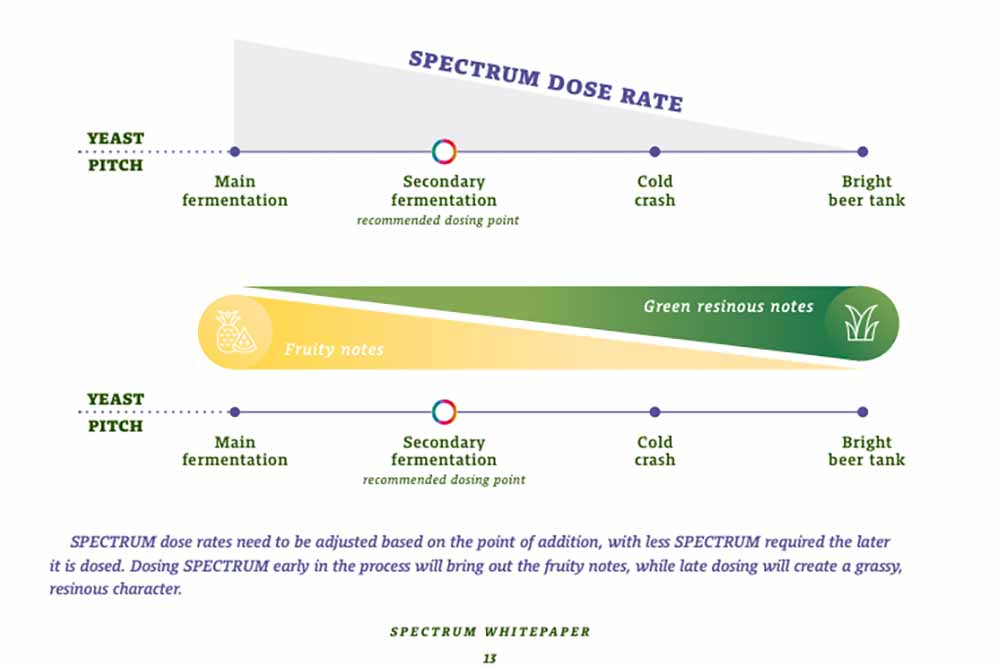
BarthHaas recommendations from SPECTRUM dose rate | Infographic courtesy of BarthHaas
Where Should I Dose With SPECTRUM?
Pitch SPECTRUM with your yeast. BarthHaas designed SPECTRUM to be a liquid dry hop replacement for cold-side applications. According to the hop supplier, SPECTRUM can be used anywhere after the whirlpool in a recipe, but they suggest using it in secondary fermentation, ideally when you are one to two degrees Plato off terminal gravity.
Mylroie agrees that you can actually dose SPECTRUM along different parts of the brewing process, but he highly recommends pitching it with your yeast. “Typically, what I do is pitch 80g per barrel into the fermenter right after I pitch yeast on my batches,” he says. “They recommend putting it in a couple days prior to the end of fermentation at the tail end.”
But here again, you need a deft hand. “If you pitch early with the yeast, the more biotransformation flavors you’ll get out of it,” says Mylroie. “The later you pitch, the more your beer will be on the grassy side and your dosage rate will have to be really low so you don’t get that hop burn.”
The earlier you pitch SPECTRUM in your fermentation, the more fruity notes you’ll get, while the later you wait evolves into grassier notes.
Works Best in West Coast IPAs and Hazies
Because we’re talking about a dry-hop replacement, SPECTRUM works best with bigger hoppy beers.
For instance, bold, bright West Coast IPAs or cloudy, juicy hazies.
More than that though, Mylroie reminds us that with those recipes are where you tend to see your biggest losses.
A Few Examples of Beers With SPECTRUM in the Market
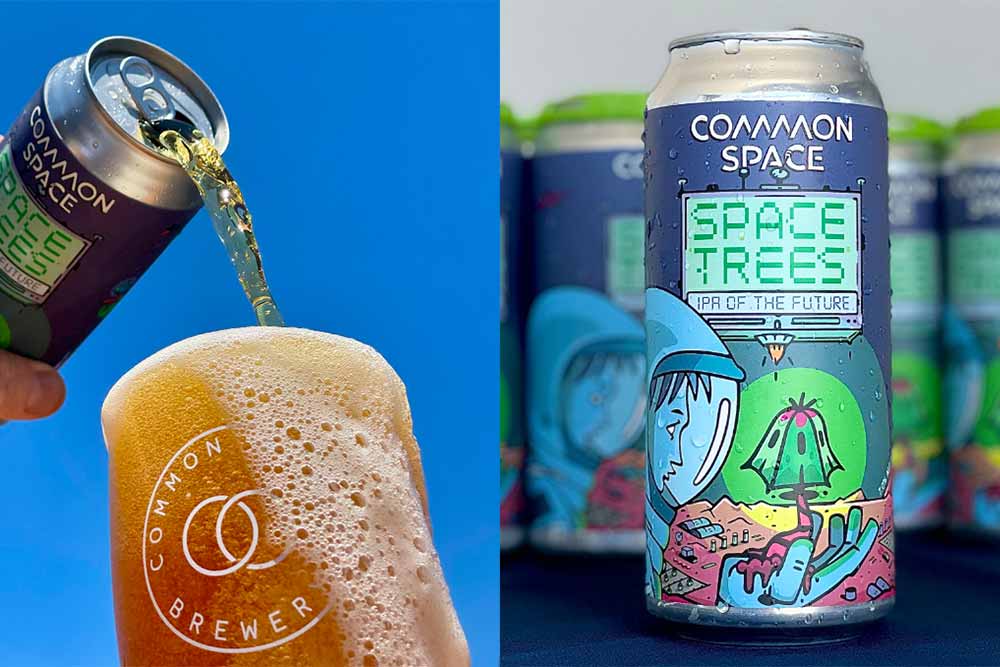
Common Space Brewery Space Trees in 2022 included just liquid hop products – Incognito and SPECTRUM | Photography courtesy of Common Space Brewery
Space Trees (2022) – Common Space Brewery, Los Angeles, CA
“We’ve been riding this evolution of the hop product train from the very beginning,” says Link. “We have a beer we make every year called Space Trees, which is the exploration of the future of hops, and every year when we make Space Trees we use exclusively the hop products that have changed since we last made Space Trees.”
As a series that explores different hop products, Space Trees in 2022 used only all-liquid hop extracts—SPECTRUM and Incognito.
Yes, you read that right. This version of Space Trees included no plant matter at all. Pretty wild.
“The beer that came out on the other side was completely unique from any beer we made using T-90 or T-45 or Cryo, or LUPOMAX, or whatever hops,” says Link. “That actually started our interest in SPECTRUM.”
According to Link, many of Common Space’s brewery friends came in to try the beer, drank it and said the same thing: “There are no hops in here whatsoever; it’s all liquid?” laughs Link. “Yes! It’s all liquid. They told me we’re crazy.”
But apparently tasting Space Trees has made even more brewers excited about trying SPECTRUM.

Burnt Mill Brewery pale ale Pintle made with Citra SPECTRUM | Photography courtesy of Burnt Mill Brewery
Pintle – Burnt Mill Brewery; Ipswich, Suffolk, England
Burnt Mill Head Brewer Sophie De Ronde originally started using SPECTRUM to get higher yields while retaining flavor. She started by replacing fifty percent of Citra pellets in the brewery’s flagship pale ale Pintle with Citra SPECTRUM before going to the full one hundred percent Citra replacement.
The beer has retained the flavor she’s looking for while reaping huge benefits on the brewing side.
“We use to dry hop Pintle at 20kg of pellets per brew,” De Ronde said in a BarthHaas case study. “At this volume, we only need to use about 3 kg of SPECTRUM to get the flavor we want. It seems to work even more efficiently at these higher volumes.”
Additionally, De Ronde notes that their yields have increased. “We have found that by decreasing our hop solids by fifty percent, we have increased yields quite dramatically, meaning that overall revenue is much higher,” she says. “On average we are saving between five percent and seven percent more beer in the dry-hopping process, which is a lot of extra beer for no extra effort.”
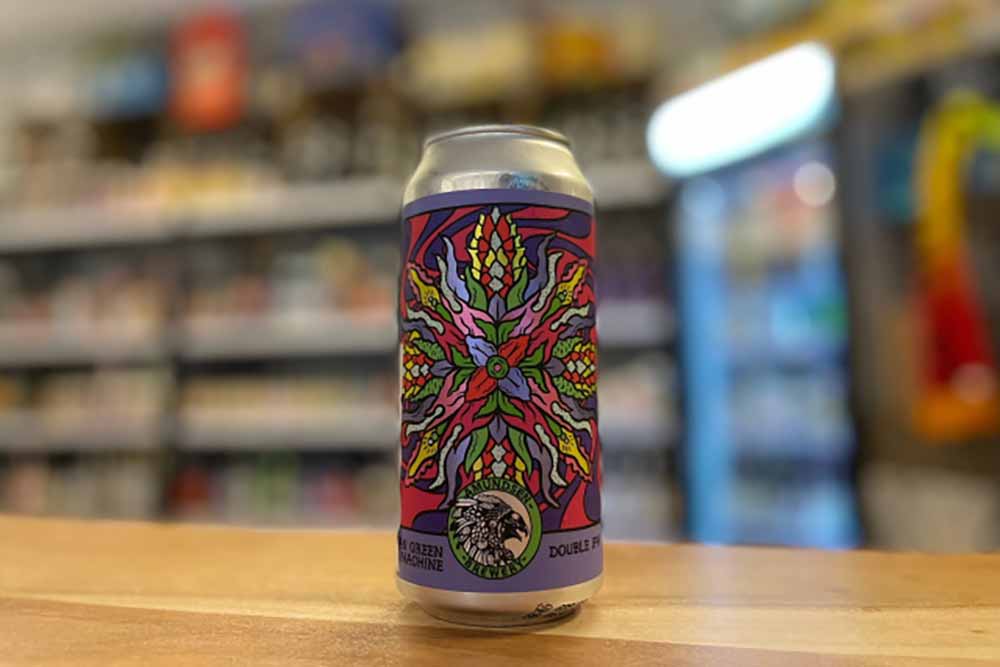
Amundsen Bryggeri Lean Green Lupulin Machine made with SPECTRUM | Photography courtesy of Craft Beer Rockstars
Lean Green Lupulin Machine – Amundsen Bryggeri; Sentrum, Oslo, Norway
Looking to specifically boost its double IPA, Double Apocalypse, Amundsen Bryggeri experimented with SPECTRUM to brew Lean Green Lupulin Machine.
An initial dosing of replacing 65kg of pellets with 12kg of SPECTRUM led to a beer that was pretty harsh and resinous.
The next go round, Amundsen Bryggeri Head Brewer Matt Arens pared back, going for 40kg of T-90 pellets in the dry hop and 5kg of SPECTRUM. “The results were striking,” he said in a BarthHaas case study. “The harsh resinous notes had disappeared and had given way to juicy orange, passion fruit, and peach flavors, making this a dangerously drinkable double IPA.”
From a brewing perspective, using SPECTRUM had tangible results. “On the last Double Apocalypse, we got 31HL and on this one we got 35.8HL unpackaged beer, which is a big difference,” says Arens. “We have never brewed a double IPA with more than 35 yields out of 40. Those are the numbers; and numbers don’t lie.”
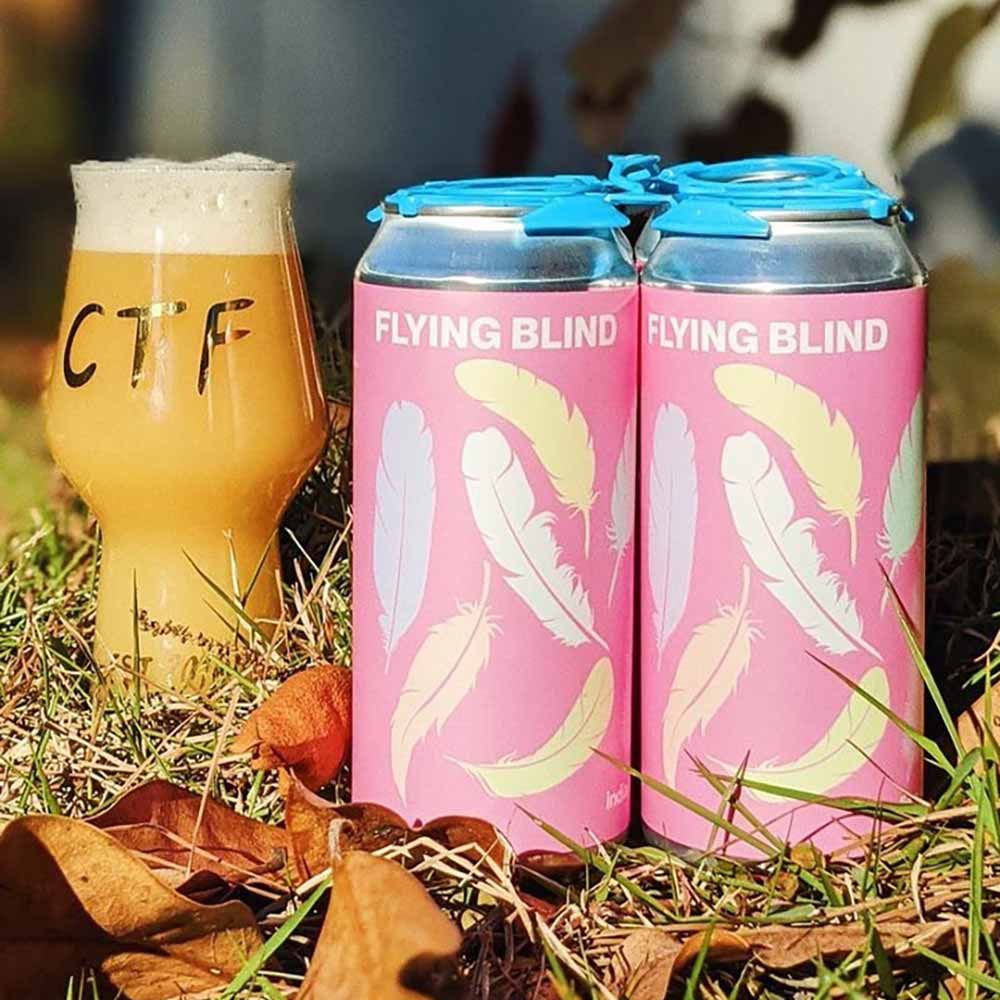
Charles Towne Fermentory x Resident Culture Brewing Company Flying Blind with SPECTRUM | Photography courtesy of Charles Towne Fermentory
Flying Blind – Charles Towne Fermentory x Resident Culture Brewing Company
When one of the best breweries in all of South Carolina teams up with one of the best breweries in Charlotte, NC, we pay attention. And when those two breweries make an American IPA with a cool new hop product called SPECTRUM…well, you can bet we are all ears (and eyes).
Flying Blind from Charles Towne Fermentory and Resident Culture showcases Motueka and revolutionary new liquid hop product Citra SPECTRUM.
The results are an incredible hazy IPA bursting with tropical flavor.
What Is the Future of SPECTRUM?
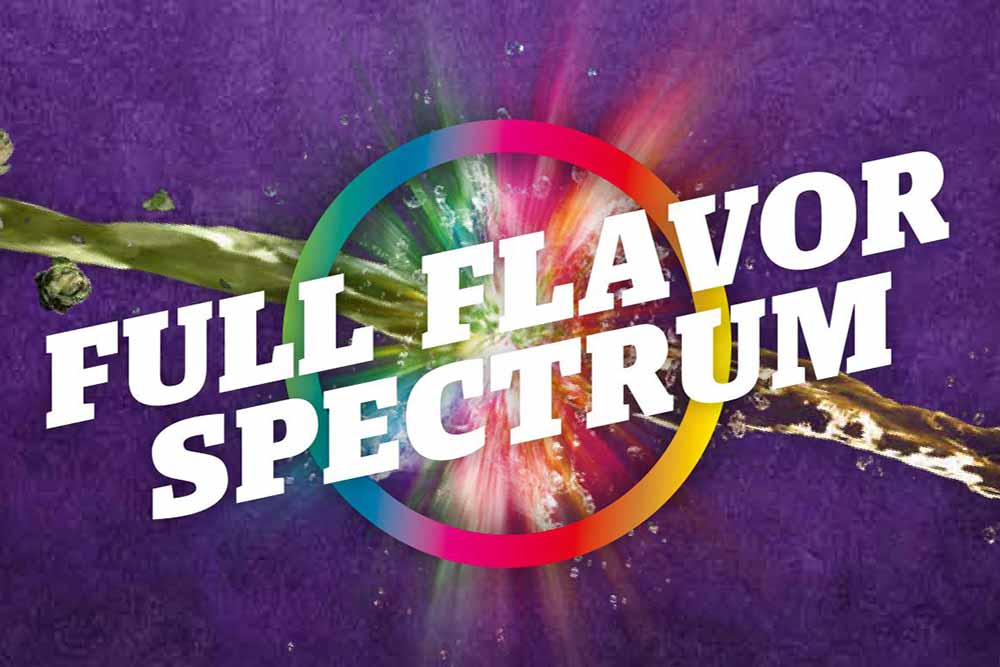
Photography courtesy of BarthHaas
With only a year out in the market, SPECTRUM is still a fairly new product.
Which means there is, of course, a bit more learning and experimenting and sharing of knowledge to be done.
“Nothing is getting in the way of adopting SPECTRUM, but it’s still just early days,” says Link.
But he does point out that many people are still hesitant to fully throw themselves to the mercy of new processes and techniques.
“We’re in a space where the way in which we make our beers, even in Southern California, a lot of people are still predominantly using T-90 hops…is crazy to our colleagues,” says Link. “Then you get to SPECTRUM and that’s a whole other level beyond.”
We suppose it’s all relative though.
As Link points out, two years ago double dry hopping meant something completely different to him than to other people in the industry. “But now it’s just a thing that everybody comes to understand…even when someone’s double dry hopping might mean something completely different than another person’s double dry hopping,” says Link. “But that’s what’s magical about craft brewing: Everyone is coming up with their own way of making great beer.”
SPECTRUM is just another weapon in your hop arsenal to help you make an incredible dry-hopped beer without losing beer or money.
Seems like SPECTRUM could be a win-win for everybody.



